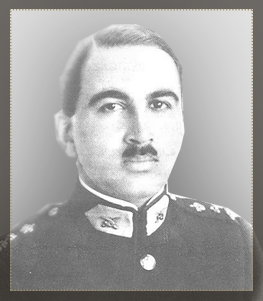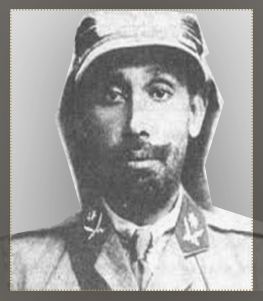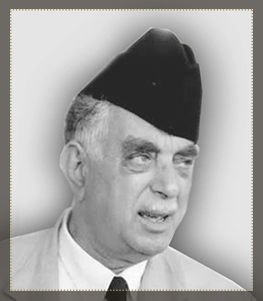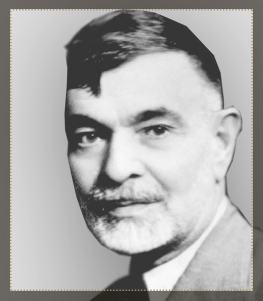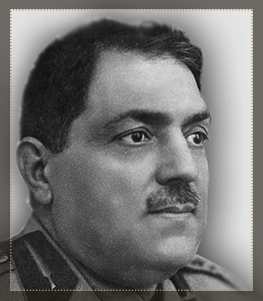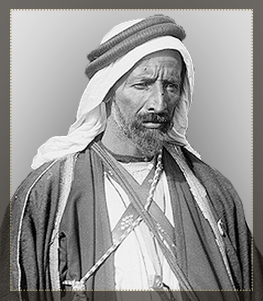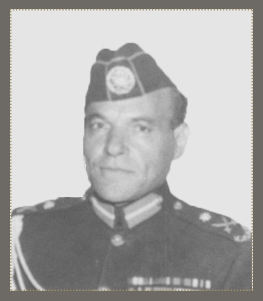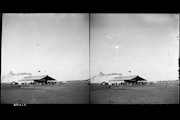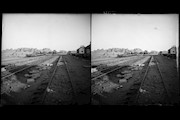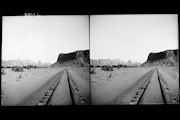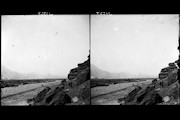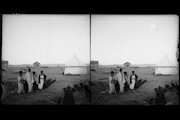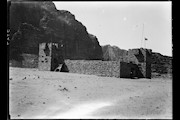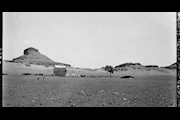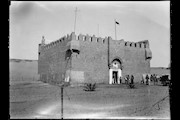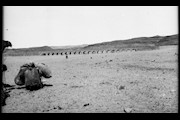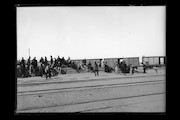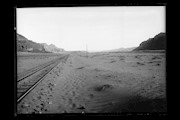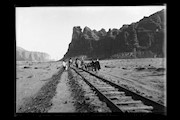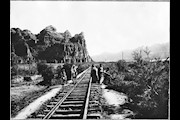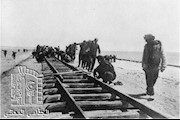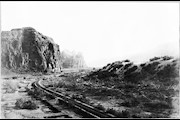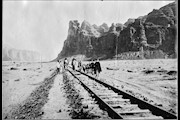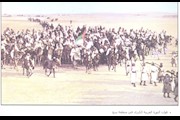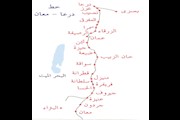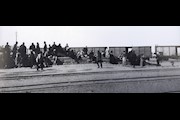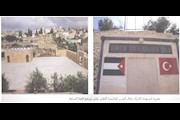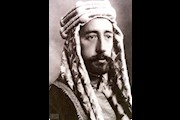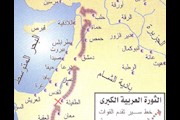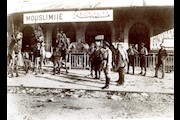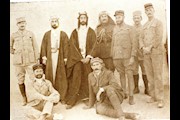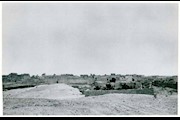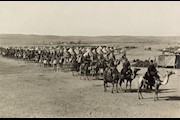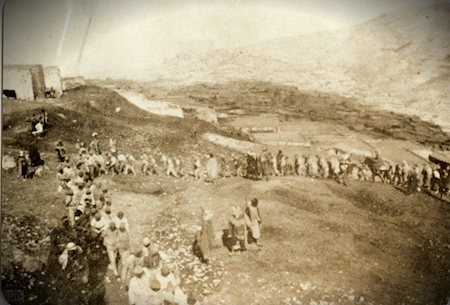
The Great Arab Revolt armies executed military operations of varying levels in the Jordanian theatre between 1 July 1917, until the end of September 1918. The operations covered almost all of Jordanian territory, according to well-set plans and accurate military vision.
The tribes of Aqeel of Hijaz, Tawaiha, Roulla, Bani Atiya, southern Maan, Hweitat, Hajaya, Karak, Bani Sakhar and northern Maan participated in these attacks.
Completing the first phase: Aqaba-Wadi Musa battles July 1917-January 1918; next came the second phase: The Battle for Tafileh January-August 1918, where Arabs began executing operations from the Qweira camp starting from mid-January 1918.
The Arab forces, led by Sharif Nasser, succeeded in liberating Jarf Al Daraweesh and advanced west to Tafileh to meet with the forces of Sharif Mastoor. When the Turkish governor, Zaki Halabi, found out about the advance of the Arab forces, he took the decision to join the Arab Revolt, which led Prince Zeid to appoint him governor of Tafileh. The decision was taken due to the following reasons:
1- The small number of forces at the Tafileh fortress, which did not exceed 250, making it vulnerable to Arab attacks.
2- The fortress was affected by the swift Arab victory in Jarf Al Daraweesh.
3- The communications by the sheikhs of Tafileh played a part in speeding up the decision.
4- The presence of an Armenian community in Tafileh, where they settled after emigrating from their homeland to escape Turkish oppression. The Arabs supported the Armenians and continued to do so in Tafileh.
It was easy for Arab forces to enter Tafileh, where they hoisted the Arab banners on 15 January 1918. A few days later, Prince Zeid, accompanied by Rasem Sardast and Subhi Al Omari, entered the city. The Arabs were aware that the Turks will attempt counterattacks to retake the outposts they lost, due to their importance.
Hadd Al Daqiq Battle 25 January 1918 — Route to Great Victory
This is one of the most important routes taken by the Arab Army while fighting a major decisive battle against the forces that marched in an attempt to retake Tafileh, save face for the Ottoman regime and restore confidence among the troops at the front after a number of defeats. Arab forces entered Tafileh on 15 January 1918 from two sides. The troops included regular forces led by the Tafileh fortress and irregular ones made up of volunteers led by Barakat Majali, the volunteers of the Bani Sakher and Aqeilat tribes and the guard forces of Prince Zeid. The men of Tafileh and its surrounding villages, especially Aimeh, were supporting these troops, in addition to the riders of Hweitat and Matalqa led by Hamad Al Arar Al Jazi, who had pledged himself to the Arab cause.
The Turks arrived in Qatraneh on 23 January 1918, and advanced to Tafileh, clashing with the Arab forces. Arab crowds converged on the battlefield after being separated due to the Jarf Al Daraweesh battle, maintaining fire density and increasing it, which brought confusion to the ranks of the Turks and pushed them to re-examine their situation.
The battle increased in intensity on the morning of 25 January 1918, with the advance of Aimeh people and their attack against the Turks from their left flank. They had climbed the steep mountain, which the Turks were not expecting, becoming powerless to use their own weapons. The Turkish forces’ general commander, Hamid Fakhri, was also killed. Signs of defeat began to show amidst their ranks, making it clear for Arabs that the battle was now theirs, so they intensified their attacks against the enemy, which started falling back.
The Arabs employed a misleading tactic to gain the upper hand, using their assault rifles’ “clickers” to make shooting noises after running out of ammunition, to make it seem like they had many weapons. This prompted Hamid Fakhri, the Turkish leader, to comment that the “Arabs have turned the rules of war upside down.”
Before sunset that day, the Arabs finished off the Turkish forces. The Turks who survived escaped to Karak and other cities. Arabs celebrated their victory in Tafileh, with one Arab soldier even wearing the uniform of slain Turkish leader Hamid Fakhri, with his weapon and all his medals, imparting a swift and effective message on the field.
The battle delivered a major blow to the Turks, and the Turkish leadership showed deep resentment of the defeat. The Arab plan was to advance towards Karak, but the cold and snowy weather led them to postpone that to implement another phase of military operations. However, Arabs ended up conquering Karak without military engagement.
The Turks then began planning retaliation against the Arab forces to prevent further advance or victory. The Arabs also started preparing for any potential developments, realising the difficult situation in Tafileh due to the enemy’s intentions to attack with heavily armed forces supported by artillery and planes, and led by Turks, Germans and Bulgarians.
The Turks began mobilising in the two stations of Al Hassa and Jarf Al Daraweesh after a bout of rain and snow tapered off in the area. The army began marching on 6 March 1918, skirmishing with the Arabs for an entire day. The Arabs were forced to fall back under heavy artillery fire and shelling from aircraft. Prince Zeid decided to retreat to maintain the cohesion of defence lines and pull the enemy into valleys to expose its forces to gunfire.
Prince Zeid’s forces held their ground on 8 March 1918, but the surprise was that the Turkish forces retreated, before returning to Tafileh on 14 March 1918. Prince Zeid’s forces, in response, returned to set camp in Rashadieh. The Turks in Tafileh destroyed many houses and sabotaged a number of locations, remaining in the city until receiving a surprise order to retreat on 23 March 1918. The Turkish leadership ordered its forces in Tafileh to withdraw and reinforce the front around Amman. After the withdrawal, the Arab forces advanced to enter Tafileh once again and start preparing for a new phase of military operations.
Women played a major role in Hadd Al Daqiq Battle, according to the memoirs of Subhi Al Omari, who writes: “We would see one woman going and another coming, each with her own assignment, each pulling her midraga [traditional Jordanian dress] with a belt, assisting a wounded fighter or moving the body of a relative.” Omari also mentioned some of the women who were wounded in the battle, such as Thuraya Khamis Al Dalabih, Hasnah Abdul Ghani, Sheikha Al Qilat Al Zeidaneen, Subhiya Al Hujjaj Al Bahratm, Subhiya Al Amayreh, Fatima Deifallah Al Amayreh, Fidhiya and Abdul Rahman Jarabaa to name a few. Some of these women became martyrs after succumbing to their wounds.
Third Phase: Maan Battles April-July 1918:
At a conference held on 8 April 1918 and chaired by Prince Faisal, a plan of operations and attack on Maan was approved for the period 11-19 April over three phases:
First phase: It came from the west, supervised by Nuri Al Said and Mawloud Mukhles, with Said heading to Ghadeer Al Haj station and successfully liberating it on 11 April. Although he succeeded in reaching the post, he later retreated to Tal Al Samnat on 17 April.
Second phase: It started from Athruh, the headquarters of Prince Zeid’s command, and it was led by Jafar Al Askari. It had two goals: take over Jardoneh station, which it managed on 13 April; and extend control over Maan station, which it managed to reach on 16 April, but had to retreat westward.
Third phase: It took place in south Maan, supervised by Sharif Nasser, and sought to reach Tal Al Shahm. It was successful on 19 April, with the area liberated and plenty of spoils gained.
This is how the first April attack on Maan, with its three axes, successfully took over Ghadeer Al Haj, Jardoneh and Tal Al Shahm stations, but failed to liberate Maan itself. Despite this failure, the soldiers proved their excellent levels of training, discipline and endurance.
More Arab attacks targeted Jardoneh outpost, with the participation of volunteers from the Liathneh, Shawabkeh, Neimat, Rashaideh and Ammarin tribes. But the post remained under Turkish control until they withdrew on 24 September 1918.
In August 1918, two camel cavalry companies were dispatched to Aqaba and headed to Mudawara outpost. On 8 August 1918, the force successfully took over the post and destroyed it. In the meantime, the Northern Arab Army was suffering under harsh weather conditions, limited weapons, supplies and transport means.
Mobilising in Azraq
The Northern Arab Army was assigned to move its base of operations from Qweira to Azraq, making it an advanced front base from which attacks are launched on Daraa and the advance northwards to Damascus can continue. A meeting chaired by Prince Faisal was held in Abu Al Lusun area, attended by Arab officers and the British liaison mission, and it was decided to divide the northern army into two groups:
The main group or the army’s main body: This continued to be led by Prince Zeid and Jafar Al Askari in Abu Al Lusun and Samneh. It was tasked with pressuring the Turkish legion in Maan and along the railway from Maan to Amman, in addition to sending a column to Madaba.
The second group: This was a mobile force made up of regular and non-regular troops and headed to the mobilisation area in Azraq, where it established advanced-front bases to launch raids on the railway in various selected areas.
The mobile forces in Azraq led by Prince Faisal were made up of regular and non-regular troops, led by Sharif Nasser bin Ali, Nouri Shaalan and Odeh Abu Tayeh from the Roulla, Hweitat, Bani Sakher and Sarhan tribes. A medical field unit accompanied them.
The campaign began its advance on 28 August 1918, passing south Maan on its way to Jafer then Bayer, and from there to Omari, then Azraq, where it arrived on September 6. Then, Prince Faisal arrived along with Arab officers. It appeared that the Turks were aware of the Arab advance, dispatching their forces for a surprise attack on Tilal Al Samnat from one side and on Wadi Al Hassa from another. However, the Arab forces retook Tilal Al Samnat and forced the Turks to withdraw to Rashadieh and onto Tafileh. Prince Faisal had facilitated this military operation by sending Sharif Nasser and Nasib Al Bakri as his representatives, with letters urging Arab tribes to collaborate for the liberation of their land. Prince Faisal’s invitation was met with response from the Arab tribes in Wadi Sarhan, Houran,and Jabal Al Druze. It was also supported by members of societies, such as Dr Ahmad Qadri, Rustum Haidar, Tahsin Qadri, Khalil Sakakini and Salim Abdul Rahman, who all joined Prince Faisal in Abu Al Lusun.
Crowds from tribes continued to join Prince Faisal after he arrived in Azraq, as evidenced by a telegraph from Prince Zeid dated 18 September 1918, in which he wrote: “All is well. Nouri Shaalan has arrived along with massive crowds, accompanied by the Druze. Every day, the delegates increase. The people of Houran are awaiting our orders to move.”
Isolating Daraa
Operations against the railway started on 13 September 1918, with the Arab forces successfully destroying the two Nasib Jaber stations in the period 14-16 September to cut communications between Daraa and Amman, and then resuming attack on this area on 18 September.
On 17 September, a regular force led by Nuri Al Said and supported by non-regular forces, in addition to volunteers from Hijaz and Houran villages, liberated Tal Arar north of Daraa despite German-Turkish air raids.
From Tal Arar, six miles north of Daraa, Nuri Al Said moved to Mzeirib village, leading a 350-strong regular forces supported by a group of Bedouins led by Sharif Nasser bin Ali, a camel cavalry company, and two French guns. In that village, a 3km railway was destroyed, effectively cutting communication between Daraa and Palestine, and between Daraa and Damascus. But the Arab force failed to destroy the Tal Shihab station due to the arrival of German-Turkish forces to reinforce the Daraa fortress. By the evening of 18 September 1918, Arabs had managed to isolate Daraa from the north, south, and west.
Taking over Maan and Amman
Turkish forces withdrew from Maan on September 22 after calling off an attack by a column on Wahida. Prince Zeid and Jafar Al Askari took advantage of this and liberated Maan on September 23. The Prince Zeid-led forces then went after the withdrawing Turkish force to take over the areas that empty of soldiers, such as Jardoneh and Jard Al Daraweesh, and to urge the residents to hinder the Turkish retreat to prevent the protecting forces of Maan from reaching Amman. The Maan contingent was intercepted, surrounded by locals, and it surrendered on 29 September 1918 in Jizah,
The Liberation of Daraa 27 September 1918
The Arab forces that helped in the Daraa operation held its position amidst volcanic rocks until 24 September, attacking a train or a bridge at night to destroy them. As a result, when the Turkish forces’ withdrawal began, Arab camel cavalry led skirmishes against them.
On the night of 24-25 September, an Arab force was dispatched from the Jordanian village of Nuaimeh, south of Irbid, led by Nuri Al Said, Sharif Nasser bin Ali, Nouri Al Shaalan, and Odeh Abu Tayeh. It headed north and succeeded on 27 September in liberating Azro station, Ghazala, Sheikh Maskin, Sheikh Saad, and Tal Arar. The residents of Houran villages participated in the Arab forces’ attacks. On the evening of 29 September, the last Turkish unit withdrew from Daraa; therefore, the Arab forces entered the city.
